International Trade and Logistics
VerifiedAdded on 2022/11/13
|12
|2371
|301
AI Summary
This essay discusses the benefits and challenges of international trade and logistics. It highlights the importance of free trade and policy recommendations for Australia. The study concludes with the need to promote free international trade. Document type: Essay. Subject: International Trade and Logistics. Course code: 9.
Contribute Materials
Your contribution can guide someone’s learning journey. Share your
documents today.
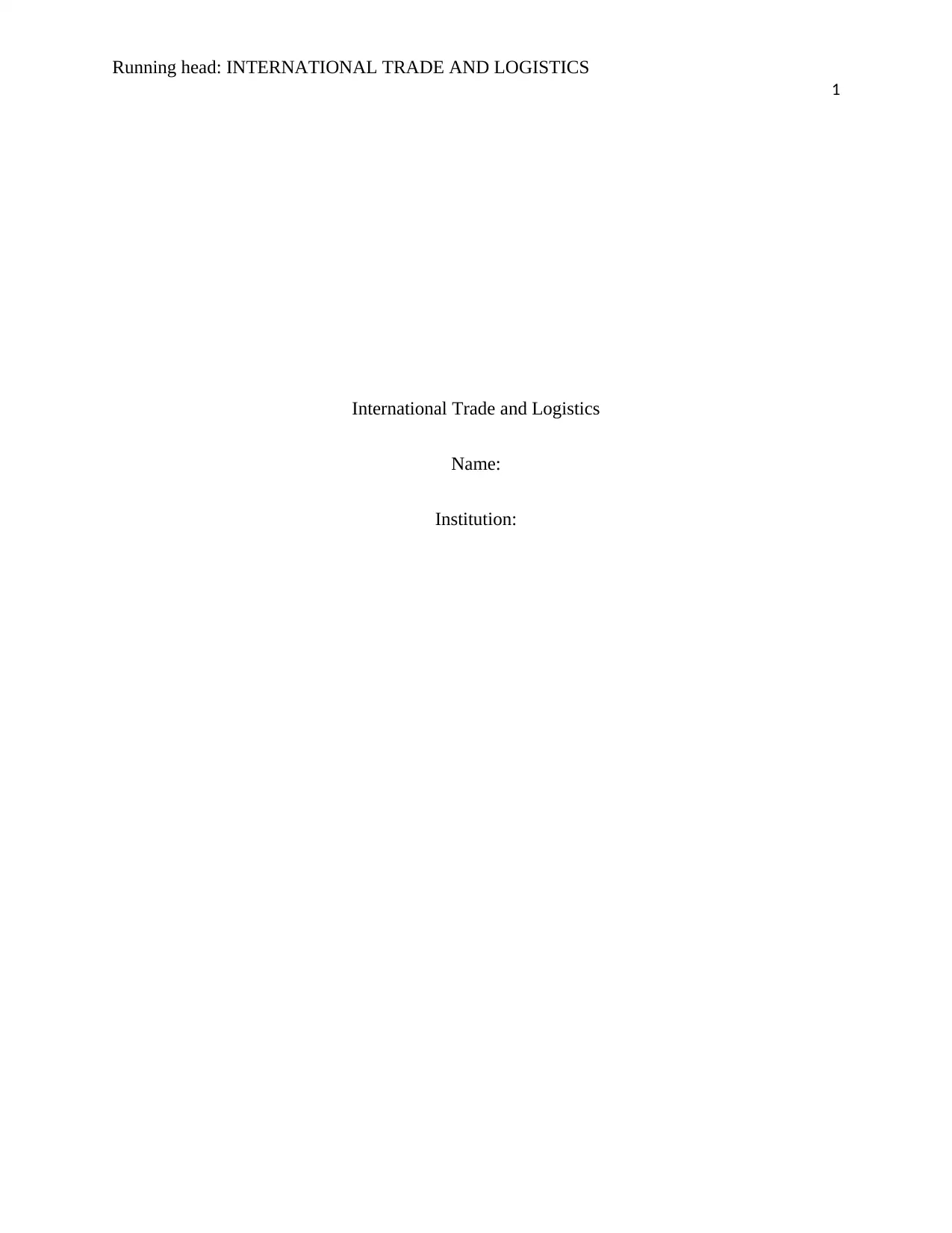
Running head: INTERNATIONAL TRADE AND LOGISTICS
1
International Trade and Logistics
Name:
Institution:
1
International Trade and Logistics
Name:
Institution:
Secure Best Marks with AI Grader
Need help grading? Try our AI Grader for instant feedback on your assignments.
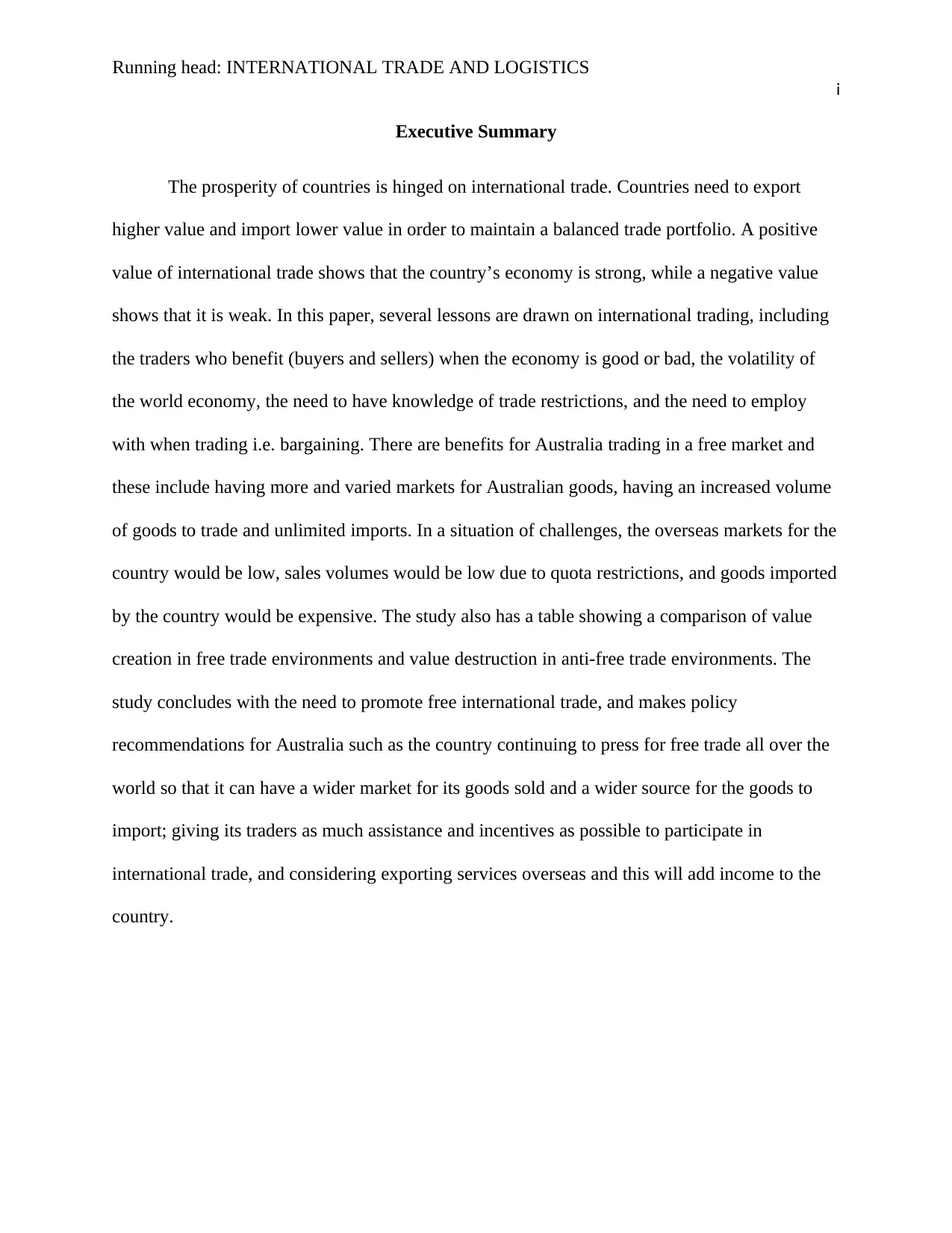
Running head: INTERNATIONAL TRADE AND LOGISTICS
i
Executive Summary
The prosperity of countries is hinged on international trade. Countries need to export
higher value and import lower value in order to maintain a balanced trade portfolio. A positive
value of international trade shows that the country’s economy is strong, while a negative value
shows that it is weak. In this paper, several lessons are drawn on international trading, including
the traders who benefit (buyers and sellers) when the economy is good or bad, the volatility of
the world economy, the need to have knowledge of trade restrictions, and the need to employ
with when trading i.e. bargaining. There are benefits for Australia trading in a free market and
these include having more and varied markets for Australian goods, having an increased volume
of goods to trade and unlimited imports. In a situation of challenges, the overseas markets for the
country would be low, sales volumes would be low due to quota restrictions, and goods imported
by the country would be expensive. The study also has a table showing a comparison of value
creation in free trade environments and value destruction in anti-free trade environments. The
study concludes with the need to promote free international trade, and makes policy
recommendations for Australia such as the country continuing to press for free trade all over the
world so that it can have a wider market for its goods sold and a wider source for the goods to
import; giving its traders as much assistance and incentives as possible to participate in
international trade, and considering exporting services overseas and this will add income to the
country.
i
Executive Summary
The prosperity of countries is hinged on international trade. Countries need to export
higher value and import lower value in order to maintain a balanced trade portfolio. A positive
value of international trade shows that the country’s economy is strong, while a negative value
shows that it is weak. In this paper, several lessons are drawn on international trading, including
the traders who benefit (buyers and sellers) when the economy is good or bad, the volatility of
the world economy, the need to have knowledge of trade restrictions, and the need to employ
with when trading i.e. bargaining. There are benefits for Australia trading in a free market and
these include having more and varied markets for Australian goods, having an increased volume
of goods to trade and unlimited imports. In a situation of challenges, the overseas markets for the
country would be low, sales volumes would be low due to quota restrictions, and goods imported
by the country would be expensive. The study also has a table showing a comparison of value
creation in free trade environments and value destruction in anti-free trade environments. The
study concludes with the need to promote free international trade, and makes policy
recommendations for Australia such as the country continuing to press for free trade all over the
world so that it can have a wider market for its goods sold and a wider source for the goods to
import; giving its traders as much assistance and incentives as possible to participate in
international trade, and considering exporting services overseas and this will add income to the
country.
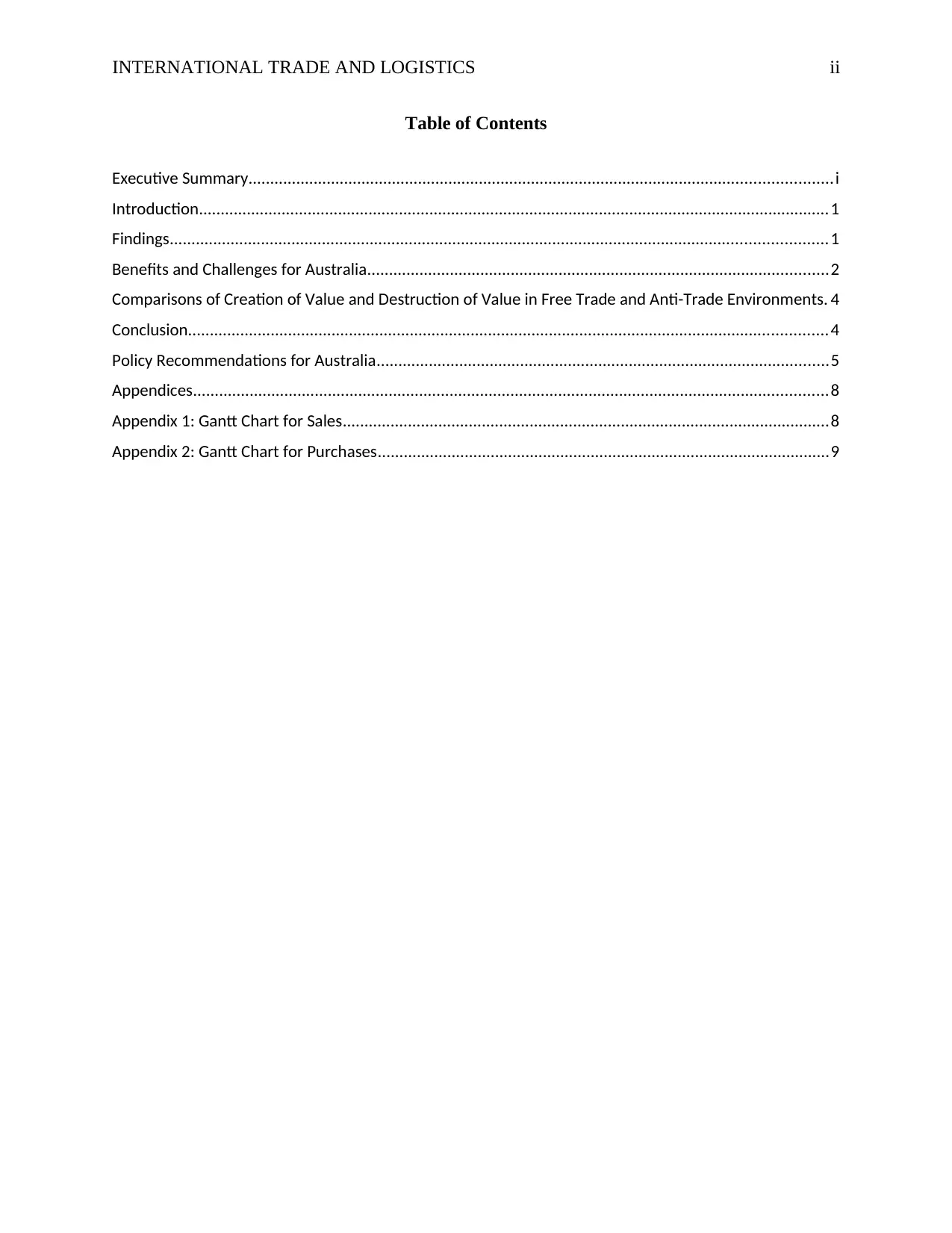
INTERNATIONAL TRADE AND LOGISTICS ii
Table of Contents
Executive Summary......................................................................................................................................i
Introduction.................................................................................................................................................1
Findings.......................................................................................................................................................1
Benefits and Challenges for Australia..........................................................................................................2
Comparisons of Creation of Value and Destruction of Value in Free Trade and Anti-Trade Environments. 4
Conclusion...................................................................................................................................................4
Policy Recommendations for Australia........................................................................................................5
Appendices..................................................................................................................................................8
Appendix 1: Gantt Chart for Sales................................................................................................................8
Appendix 2: Gantt Chart for Purchases........................................................................................................9
Table of Contents
Executive Summary......................................................................................................................................i
Introduction.................................................................................................................................................1
Findings.......................................................................................................................................................1
Benefits and Challenges for Australia..........................................................................................................2
Comparisons of Creation of Value and Destruction of Value in Free Trade and Anti-Trade Environments. 4
Conclusion...................................................................................................................................................4
Policy Recommendations for Australia........................................................................................................5
Appendices..................................................................................................................................................8
Appendix 1: Gantt Chart for Sales................................................................................................................8
Appendix 2: Gantt Chart for Purchases........................................................................................................9
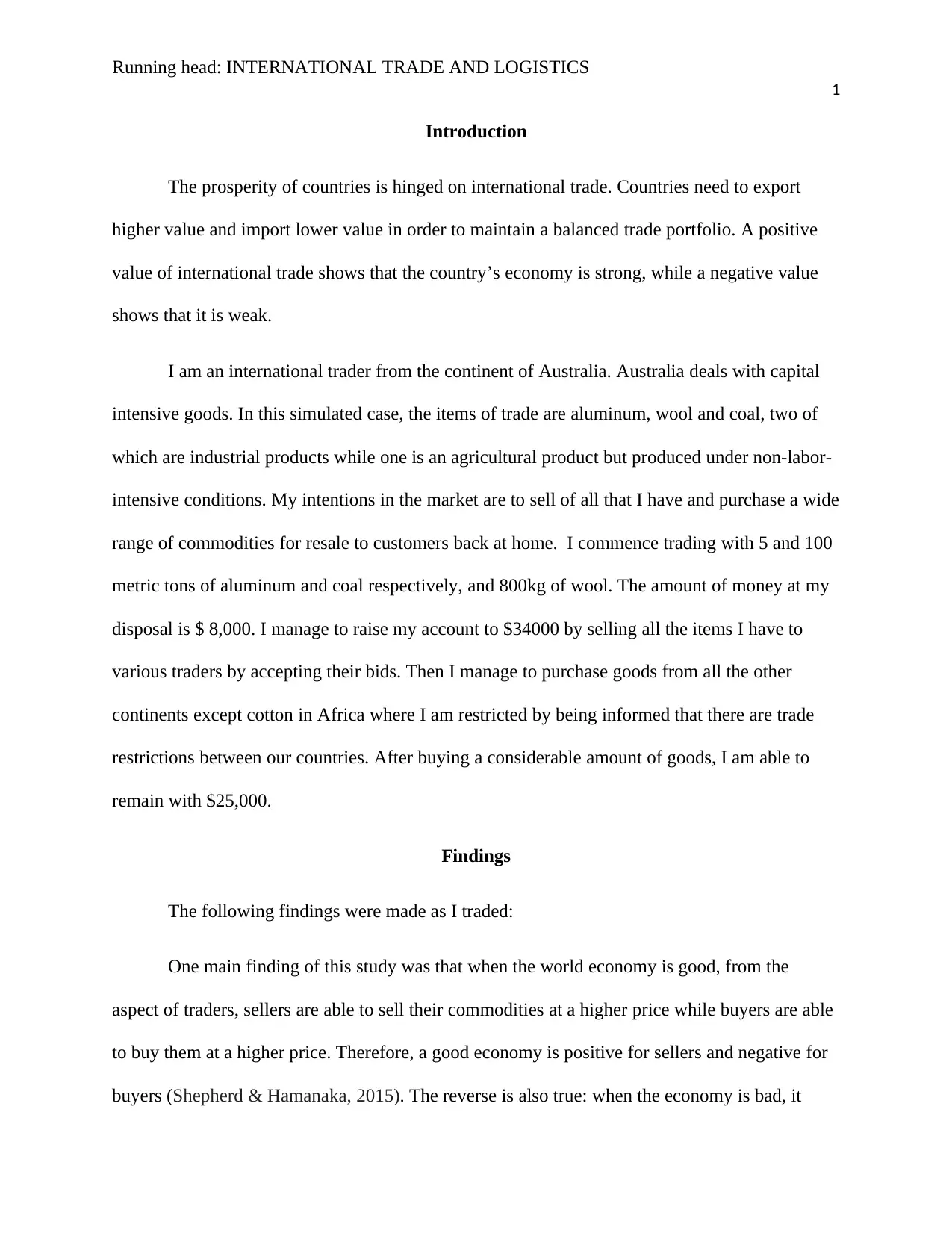
Running head: INTERNATIONAL TRADE AND LOGISTICS
1
Introduction
The prosperity of countries is hinged on international trade. Countries need to export
higher value and import lower value in order to maintain a balanced trade portfolio. A positive
value of international trade shows that the country’s economy is strong, while a negative value
shows that it is weak.
I am an international trader from the continent of Australia. Australia deals with capital
intensive goods. In this simulated case, the items of trade are aluminum, wool and coal, two of
which are industrial products while one is an agricultural product but produced under non-labor-
intensive conditions. My intentions in the market are to sell of all that I have and purchase a wide
range of commodities for resale to customers back at home. I commence trading with 5 and 100
metric tons of aluminum and coal respectively, and 800kg of wool. The amount of money at my
disposal is $ 8,000. I manage to raise my account to $34000 by selling all the items I have to
various traders by accepting their bids. Then I manage to purchase goods from all the other
continents except cotton in Africa where I am restricted by being informed that there are trade
restrictions between our countries. After buying a considerable amount of goods, I am able to
remain with $25,000.
Findings
The following findings were made as I traded:
One main finding of this study was that when the world economy is good, from the
aspect of traders, sellers are able to sell their commodities at a higher price while buyers are able
to buy them at a higher price. Therefore, a good economy is positive for sellers and negative for
buyers (Shepherd & Hamanaka, 2015). The reverse is also true: when the economy is bad, it
1
Introduction
The prosperity of countries is hinged on international trade. Countries need to export
higher value and import lower value in order to maintain a balanced trade portfolio. A positive
value of international trade shows that the country’s economy is strong, while a negative value
shows that it is weak.
I am an international trader from the continent of Australia. Australia deals with capital
intensive goods. In this simulated case, the items of trade are aluminum, wool and coal, two of
which are industrial products while one is an agricultural product but produced under non-labor-
intensive conditions. My intentions in the market are to sell of all that I have and purchase a wide
range of commodities for resale to customers back at home. I commence trading with 5 and 100
metric tons of aluminum and coal respectively, and 800kg of wool. The amount of money at my
disposal is $ 8,000. I manage to raise my account to $34000 by selling all the items I have to
various traders by accepting their bids. Then I manage to purchase goods from all the other
continents except cotton in Africa where I am restricted by being informed that there are trade
restrictions between our countries. After buying a considerable amount of goods, I am able to
remain with $25,000.
Findings
The following findings were made as I traded:
One main finding of this study was that when the world economy is good, from the
aspect of traders, sellers are able to sell their commodities at a higher price while buyers are able
to buy them at a higher price. Therefore, a good economy is positive for sellers and negative for
buyers (Shepherd & Hamanaka, 2015). The reverse is also true: when the economy is bad, it
Secure Best Marks with AI Grader
Need help grading? Try our AI Grader for instant feedback on your assignments.
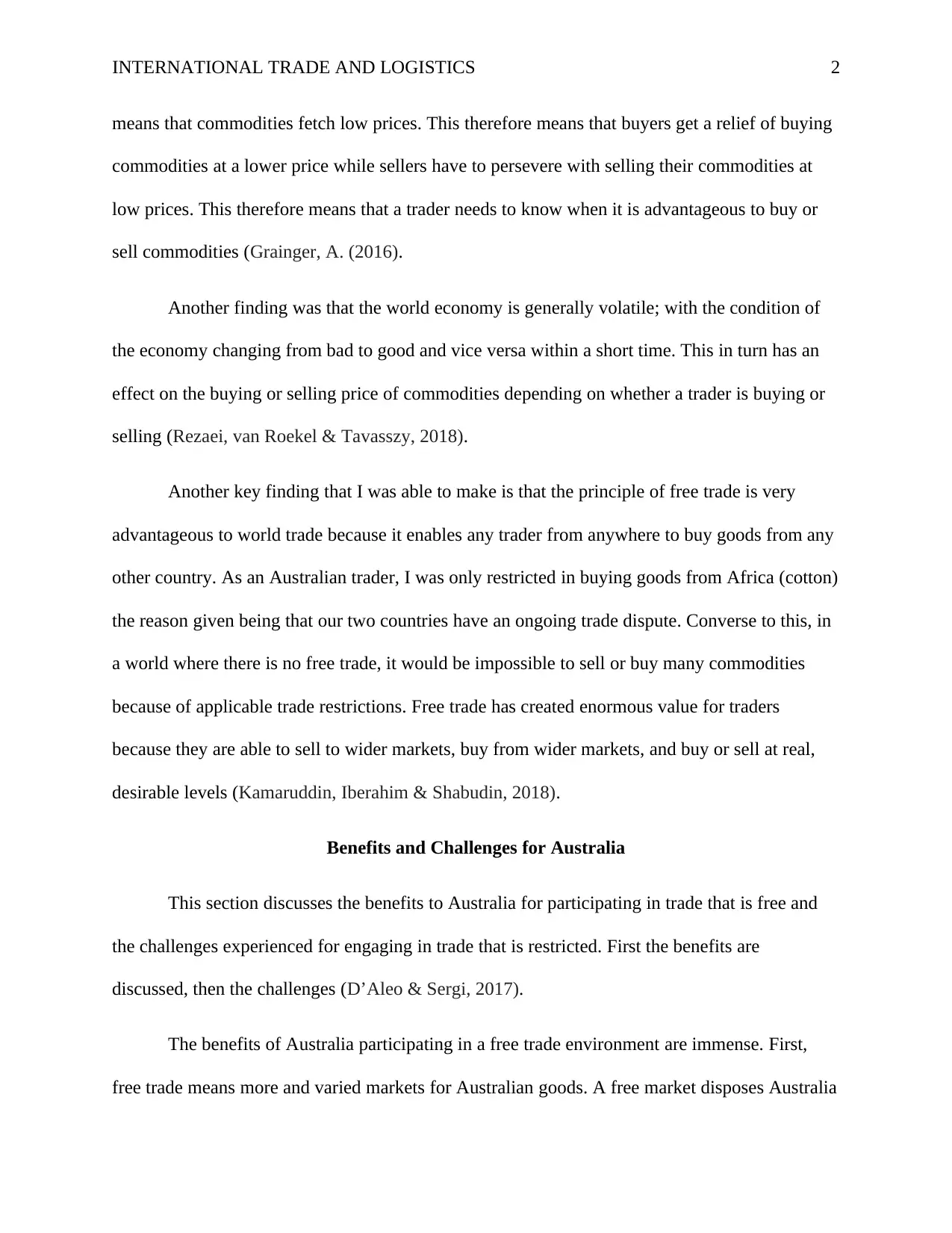
INTERNATIONAL TRADE AND LOGISTICS 2
means that commodities fetch low prices. This therefore means that buyers get a relief of buying
commodities at a lower price while sellers have to persevere with selling their commodities at
low prices. This therefore means that a trader needs to know when it is advantageous to buy or
sell commodities (Grainger, A. (2016).
Another finding was that the world economy is generally volatile; with the condition of
the economy changing from bad to good and vice versa within a short time. This in turn has an
effect on the buying or selling price of commodities depending on whether a trader is buying or
selling (Rezaei, van Roekel & Tavasszy, 2018).
Another key finding that I was able to make is that the principle of free trade is very
advantageous to world trade because it enables any trader from anywhere to buy goods from any
other country. As an Australian trader, I was only restricted in buying goods from Africa (cotton)
the reason given being that our two countries have an ongoing trade dispute. Converse to this, in
a world where there is no free trade, it would be impossible to sell or buy many commodities
because of applicable trade restrictions. Free trade has created enormous value for traders
because they are able to sell to wider markets, buy from wider markets, and buy or sell at real,
desirable levels (Kamaruddin, Iberahim & Shabudin, 2018).
Benefits and Challenges for Australia
This section discusses the benefits to Australia for participating in trade that is free and
the challenges experienced for engaging in trade that is restricted. First the benefits are
discussed, then the challenges (D’Aleo & Sergi, 2017).
The benefits of Australia participating in a free trade environment are immense. First,
free trade means more and varied markets for Australian goods. A free market disposes Australia
means that commodities fetch low prices. This therefore means that buyers get a relief of buying
commodities at a lower price while sellers have to persevere with selling their commodities at
low prices. This therefore means that a trader needs to know when it is advantageous to buy or
sell commodities (Grainger, A. (2016).
Another finding was that the world economy is generally volatile; with the condition of
the economy changing from bad to good and vice versa within a short time. This in turn has an
effect on the buying or selling price of commodities depending on whether a trader is buying or
selling (Rezaei, van Roekel & Tavasszy, 2018).
Another key finding that I was able to make is that the principle of free trade is very
advantageous to world trade because it enables any trader from anywhere to buy goods from any
other country. As an Australian trader, I was only restricted in buying goods from Africa (cotton)
the reason given being that our two countries have an ongoing trade dispute. Converse to this, in
a world where there is no free trade, it would be impossible to sell or buy many commodities
because of applicable trade restrictions. Free trade has created enormous value for traders
because they are able to sell to wider markets, buy from wider markets, and buy or sell at real,
desirable levels (Kamaruddin, Iberahim & Shabudin, 2018).
Benefits and Challenges for Australia
This section discusses the benefits to Australia for participating in trade that is free and
the challenges experienced for engaging in trade that is restricted. First the benefits are
discussed, then the challenges (D’Aleo & Sergi, 2017).
The benefits of Australia participating in a free trade environment are immense. First,
free trade means more and varied markets for Australian goods. A free market disposes Australia
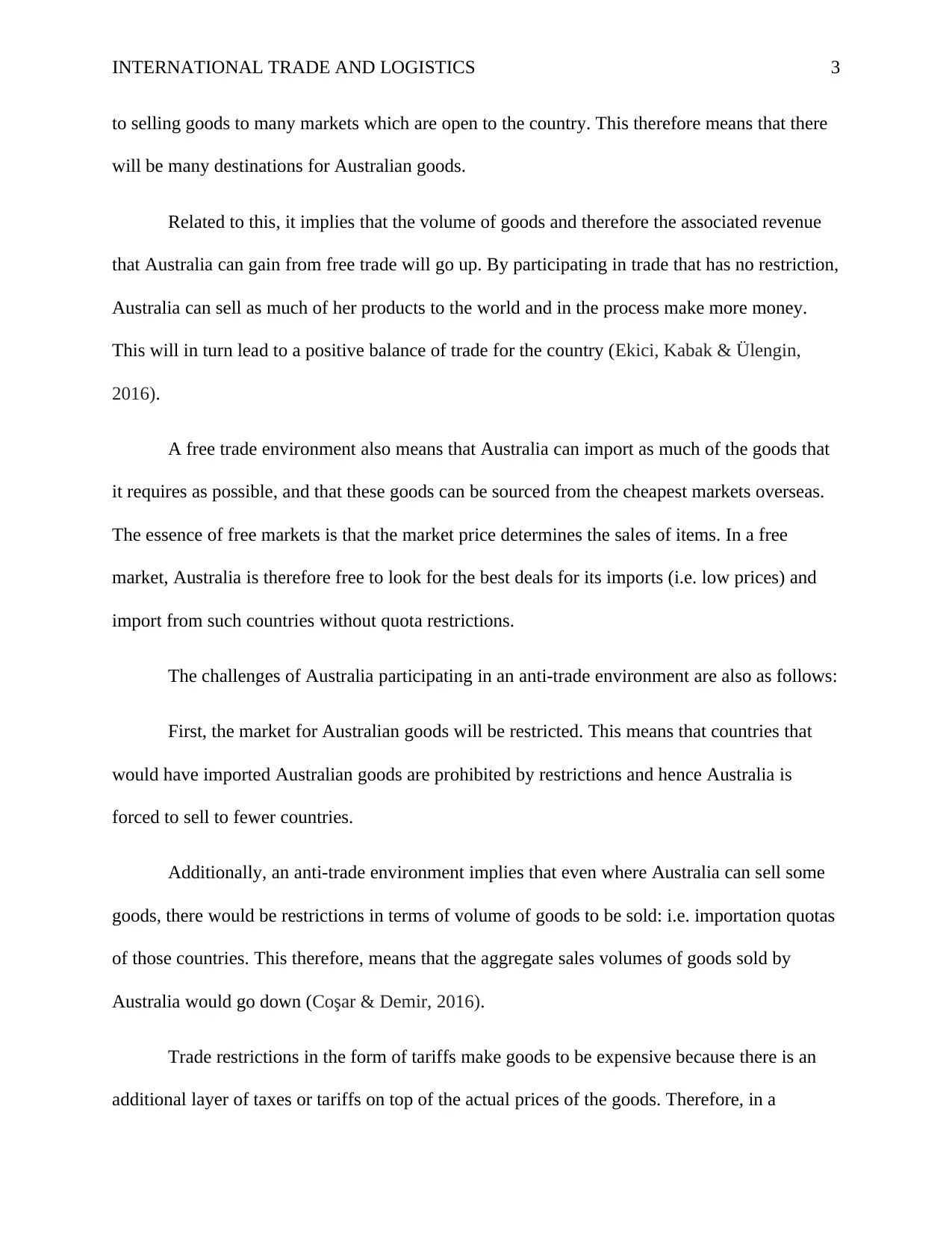
INTERNATIONAL TRADE AND LOGISTICS 3
to selling goods to many markets which are open to the country. This therefore means that there
will be many destinations for Australian goods.
Related to this, it implies that the volume of goods and therefore the associated revenue
that Australia can gain from free trade will go up. By participating in trade that has no restriction,
Australia can sell as much of her products to the world and in the process make more money.
This will in turn lead to a positive balance of trade for the country (Ekici, Kabak & Ülengin,
2016).
A free trade environment also means that Australia can import as much of the goods that
it requires as possible, and that these goods can be sourced from the cheapest markets overseas.
The essence of free markets is that the market price determines the sales of items. In a free
market, Australia is therefore free to look for the best deals for its imports (i.e. low prices) and
import from such countries without quota restrictions.
The challenges of Australia participating in an anti-trade environment are also as follows:
First, the market for Australian goods will be restricted. This means that countries that
would have imported Australian goods are prohibited by restrictions and hence Australia is
forced to sell to fewer countries.
Additionally, an anti-trade environment implies that even where Australia can sell some
goods, there would be restrictions in terms of volume of goods to be sold: i.e. importation quotas
of those countries. This therefore, means that the aggregate sales volumes of goods sold by
Australia would go down (Coşar & Demir, 2016).
Trade restrictions in the form of tariffs make goods to be expensive because there is an
additional layer of taxes or tariffs on top of the actual prices of the goods. Therefore, in a
to selling goods to many markets which are open to the country. This therefore means that there
will be many destinations for Australian goods.
Related to this, it implies that the volume of goods and therefore the associated revenue
that Australia can gain from free trade will go up. By participating in trade that has no restriction,
Australia can sell as much of her products to the world and in the process make more money.
This will in turn lead to a positive balance of trade for the country (Ekici, Kabak & Ülengin,
2016).
A free trade environment also means that Australia can import as much of the goods that
it requires as possible, and that these goods can be sourced from the cheapest markets overseas.
The essence of free markets is that the market price determines the sales of items. In a free
market, Australia is therefore free to look for the best deals for its imports (i.e. low prices) and
import from such countries without quota restrictions.
The challenges of Australia participating in an anti-trade environment are also as follows:
First, the market for Australian goods will be restricted. This means that countries that
would have imported Australian goods are prohibited by restrictions and hence Australia is
forced to sell to fewer countries.
Additionally, an anti-trade environment implies that even where Australia can sell some
goods, there would be restrictions in terms of volume of goods to be sold: i.e. importation quotas
of those countries. This therefore, means that the aggregate sales volumes of goods sold by
Australia would go down (Coşar & Demir, 2016).
Trade restrictions in the form of tariffs make goods to be expensive because there is an
additional layer of taxes or tariffs on top of the actual prices of the goods. Therefore, in a
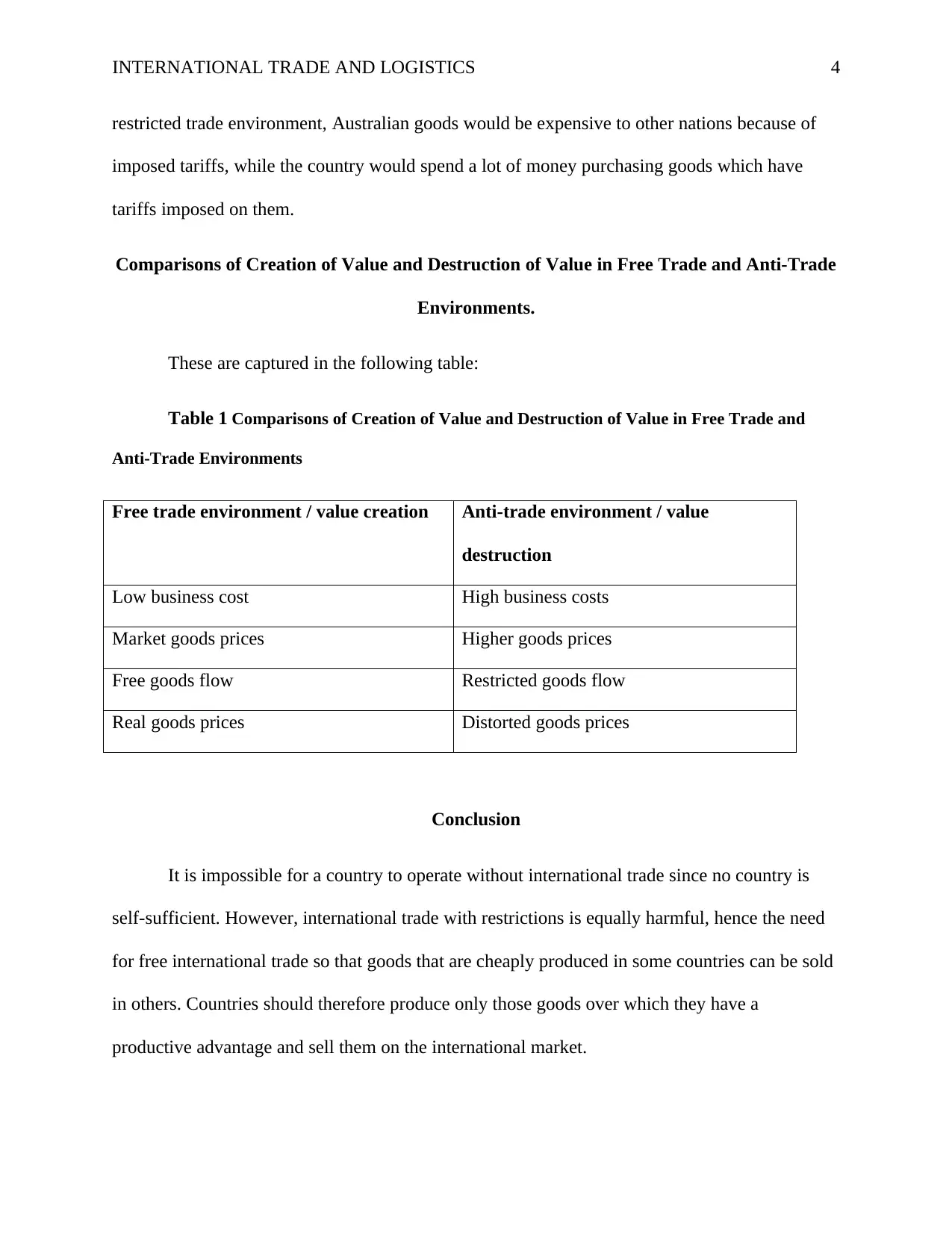
INTERNATIONAL TRADE AND LOGISTICS 4
restricted trade environment, Australian goods would be expensive to other nations because of
imposed tariffs, while the country would spend a lot of money purchasing goods which have
tariffs imposed on them.
Comparisons of Creation of Value and Destruction of Value in Free Trade and Anti-Trade
Environments.
These are captured in the following table:
Table 1 Comparisons of Creation of Value and Destruction of Value in Free Trade and
Anti-Trade Environments
Free trade environment / value creation Anti-trade environment / value
destruction
Low business cost High business costs
Market goods prices Higher goods prices
Free goods flow Restricted goods flow
Real goods prices Distorted goods prices
Conclusion
It is impossible for a country to operate without international trade since no country is
self-sufficient. However, international trade with restrictions is equally harmful, hence the need
for free international trade so that goods that are cheaply produced in some countries can be sold
in others. Countries should therefore produce only those goods over which they have a
productive advantage and sell them on the international market.
restricted trade environment, Australian goods would be expensive to other nations because of
imposed tariffs, while the country would spend a lot of money purchasing goods which have
tariffs imposed on them.
Comparisons of Creation of Value and Destruction of Value in Free Trade and Anti-Trade
Environments.
These are captured in the following table:
Table 1 Comparisons of Creation of Value and Destruction of Value in Free Trade and
Anti-Trade Environments
Free trade environment / value creation Anti-trade environment / value
destruction
Low business cost High business costs
Market goods prices Higher goods prices
Free goods flow Restricted goods flow
Real goods prices Distorted goods prices
Conclusion
It is impossible for a country to operate without international trade since no country is
self-sufficient. However, international trade with restrictions is equally harmful, hence the need
for free international trade so that goods that are cheaply produced in some countries can be sold
in others. Countries should therefore produce only those goods over which they have a
productive advantage and sell them on the international market.
Paraphrase This Document
Need a fresh take? Get an instant paraphrase of this document with our AI Paraphraser
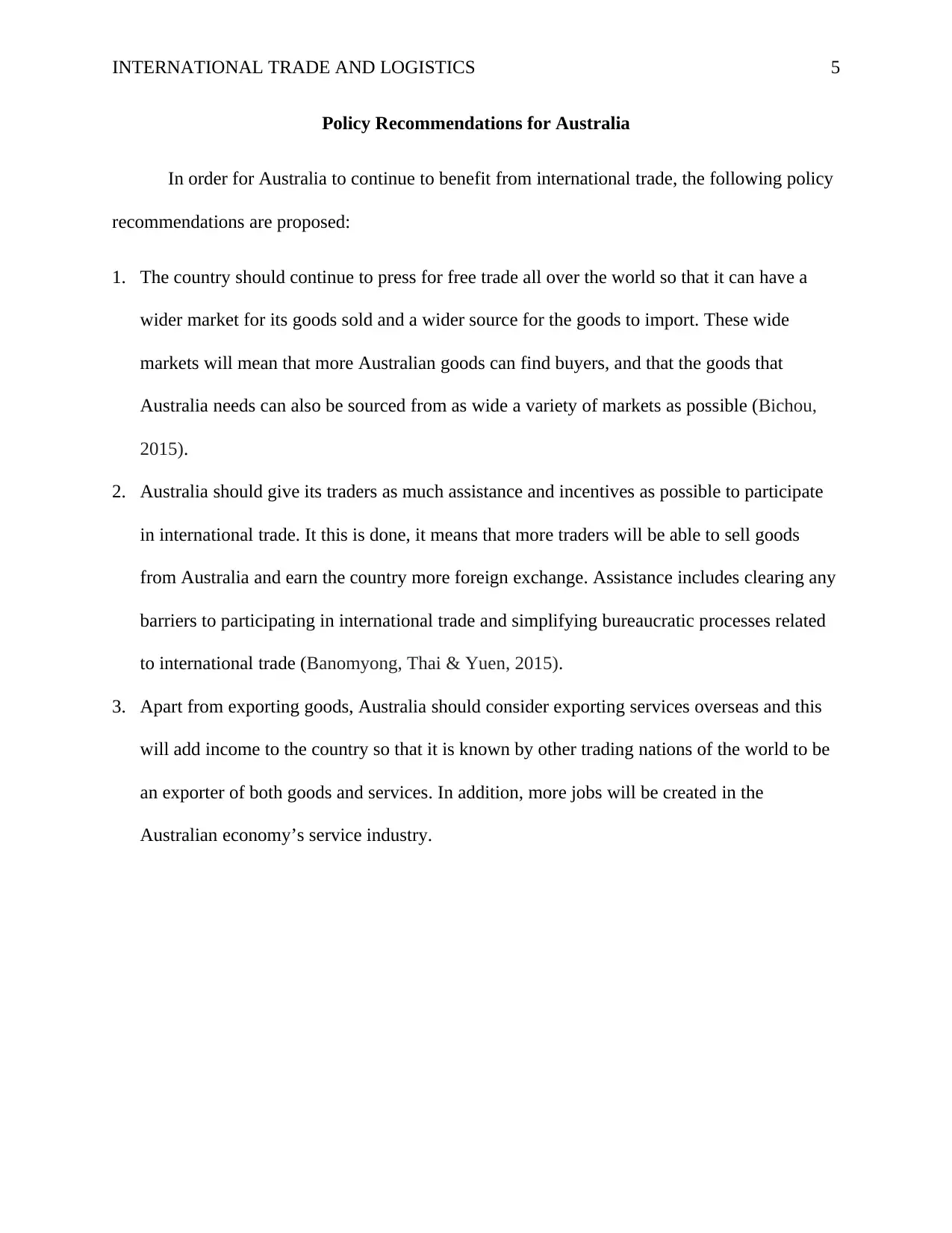
INTERNATIONAL TRADE AND LOGISTICS 5
Policy Recommendations for Australia
In order for Australia to continue to benefit from international trade, the following policy
recommendations are proposed:
1. The country should continue to press for free trade all over the world so that it can have a
wider market for its goods sold and a wider source for the goods to import. These wide
markets will mean that more Australian goods can find buyers, and that the goods that
Australia needs can also be sourced from as wide a variety of markets as possible (Bichou,
2015).
2. Australia should give its traders as much assistance and incentives as possible to participate
in international trade. It this is done, it means that more traders will be able to sell goods
from Australia and earn the country more foreign exchange. Assistance includes clearing any
barriers to participating in international trade and simplifying bureaucratic processes related
to international trade (Banomyong, Thai & Yuen, 2015).
3. Apart from exporting goods, Australia should consider exporting services overseas and this
will add income to the country so that it is known by other trading nations of the world to be
an exporter of both goods and services. In addition, more jobs will be created in the
Australian economy’s service industry.
Policy Recommendations for Australia
In order for Australia to continue to benefit from international trade, the following policy
recommendations are proposed:
1. The country should continue to press for free trade all over the world so that it can have a
wider market for its goods sold and a wider source for the goods to import. These wide
markets will mean that more Australian goods can find buyers, and that the goods that
Australia needs can also be sourced from as wide a variety of markets as possible (Bichou,
2015).
2. Australia should give its traders as much assistance and incentives as possible to participate
in international trade. It this is done, it means that more traders will be able to sell goods
from Australia and earn the country more foreign exchange. Assistance includes clearing any
barriers to participating in international trade and simplifying bureaucratic processes related
to international trade (Banomyong, Thai & Yuen, 2015).
3. Apart from exporting goods, Australia should consider exporting services overseas and this
will add income to the country so that it is known by other trading nations of the world to be
an exporter of both goods and services. In addition, more jobs will be created in the
Australian economy’s service industry.
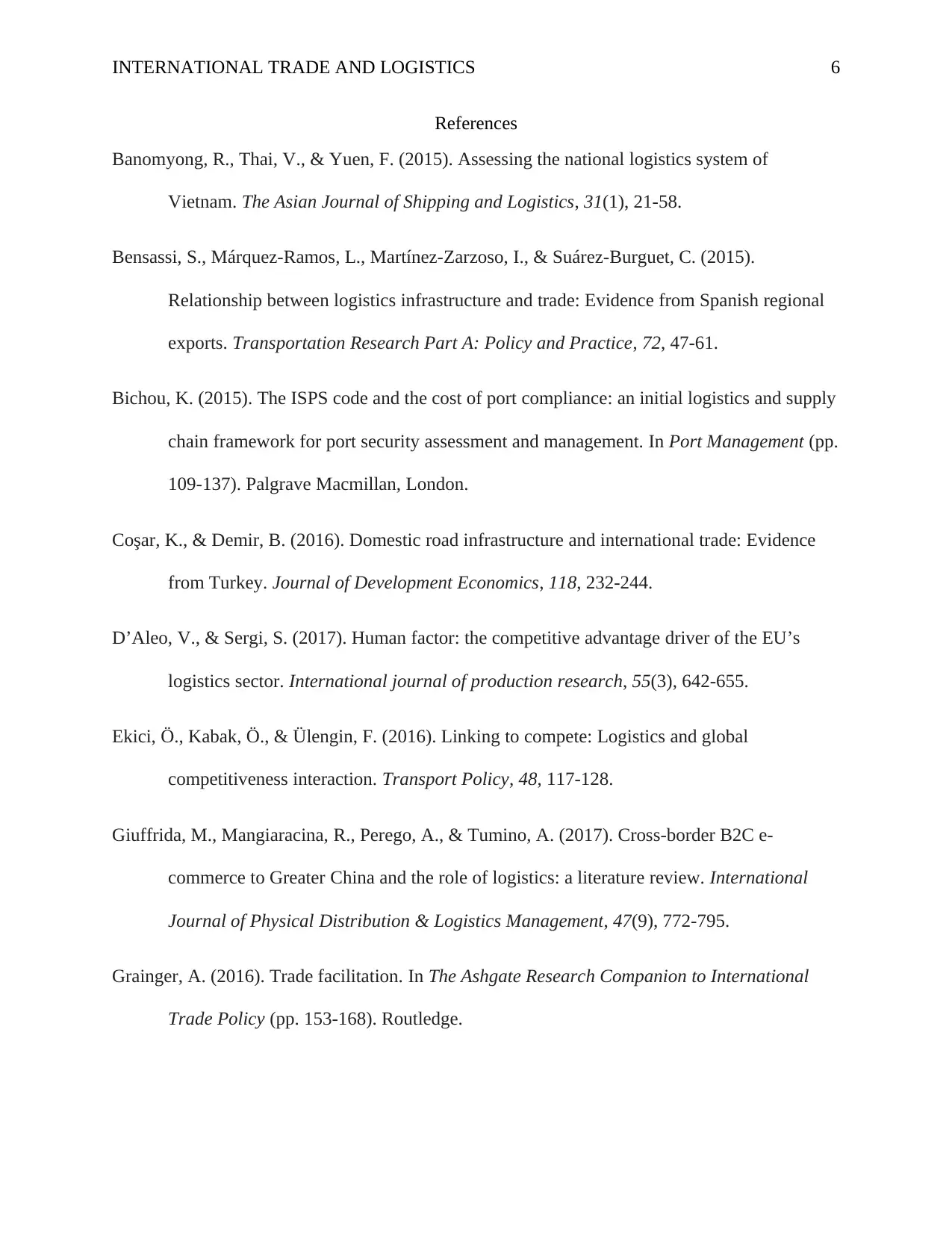
INTERNATIONAL TRADE AND LOGISTICS 6
References
Banomyong, R., Thai, V., & Yuen, F. (2015). Assessing the national logistics system of
Vietnam. The Asian Journal of Shipping and Logistics, 31(1), 21-58.
Bensassi, S., Márquez-Ramos, L., Martínez-Zarzoso, I., & Suárez-Burguet, C. (2015).
Relationship between logistics infrastructure and trade: Evidence from Spanish regional
exports. Transportation Research Part A: Policy and Practice, 72, 47-61.
Bichou, K. (2015). The ISPS code and the cost of port compliance: an initial logistics and supply
chain framework for port security assessment and management. In Port Management (pp.
109-137). Palgrave Macmillan, London.
Coşar, K., & Demir, B. (2016). Domestic road infrastructure and international trade: Evidence
from Turkey. Journal of Development Economics, 118, 232-244.
D’Aleo, V., & Sergi, S. (2017). Human factor: the competitive advantage driver of the EU’s
logistics sector. International journal of production research, 55(3), 642-655.
Ekici, Ö., Kabak, Ö., & Ülengin, F. (2016). Linking to compete: Logistics and global
competitiveness interaction. Transport Policy, 48, 117-128.
Giuffrida, M., Mangiaracina, R., Perego, A., & Tumino, A. (2017). Cross-border B2C e-
commerce to Greater China and the role of logistics: a literature review. International
Journal of Physical Distribution & Logistics Management, 47(9), 772-795.
Grainger, A. (2016). Trade facilitation. In The Ashgate Research Companion to International
Trade Policy (pp. 153-168). Routledge.
References
Banomyong, R., Thai, V., & Yuen, F. (2015). Assessing the national logistics system of
Vietnam. The Asian Journal of Shipping and Logistics, 31(1), 21-58.
Bensassi, S., Márquez-Ramos, L., Martínez-Zarzoso, I., & Suárez-Burguet, C. (2015).
Relationship between logistics infrastructure and trade: Evidence from Spanish regional
exports. Transportation Research Part A: Policy and Practice, 72, 47-61.
Bichou, K. (2015). The ISPS code and the cost of port compliance: an initial logistics and supply
chain framework for port security assessment and management. In Port Management (pp.
109-137). Palgrave Macmillan, London.
Coşar, K., & Demir, B. (2016). Domestic road infrastructure and international trade: Evidence
from Turkey. Journal of Development Economics, 118, 232-244.
D’Aleo, V., & Sergi, S. (2017). Human factor: the competitive advantage driver of the EU’s
logistics sector. International journal of production research, 55(3), 642-655.
Ekici, Ö., Kabak, Ö., & Ülengin, F. (2016). Linking to compete: Logistics and global
competitiveness interaction. Transport Policy, 48, 117-128.
Giuffrida, M., Mangiaracina, R., Perego, A., & Tumino, A. (2017). Cross-border B2C e-
commerce to Greater China and the role of logistics: a literature review. International
Journal of Physical Distribution & Logistics Management, 47(9), 772-795.
Grainger, A. (2016). Trade facilitation. In The Ashgate Research Companion to International
Trade Policy (pp. 153-168). Routledge.
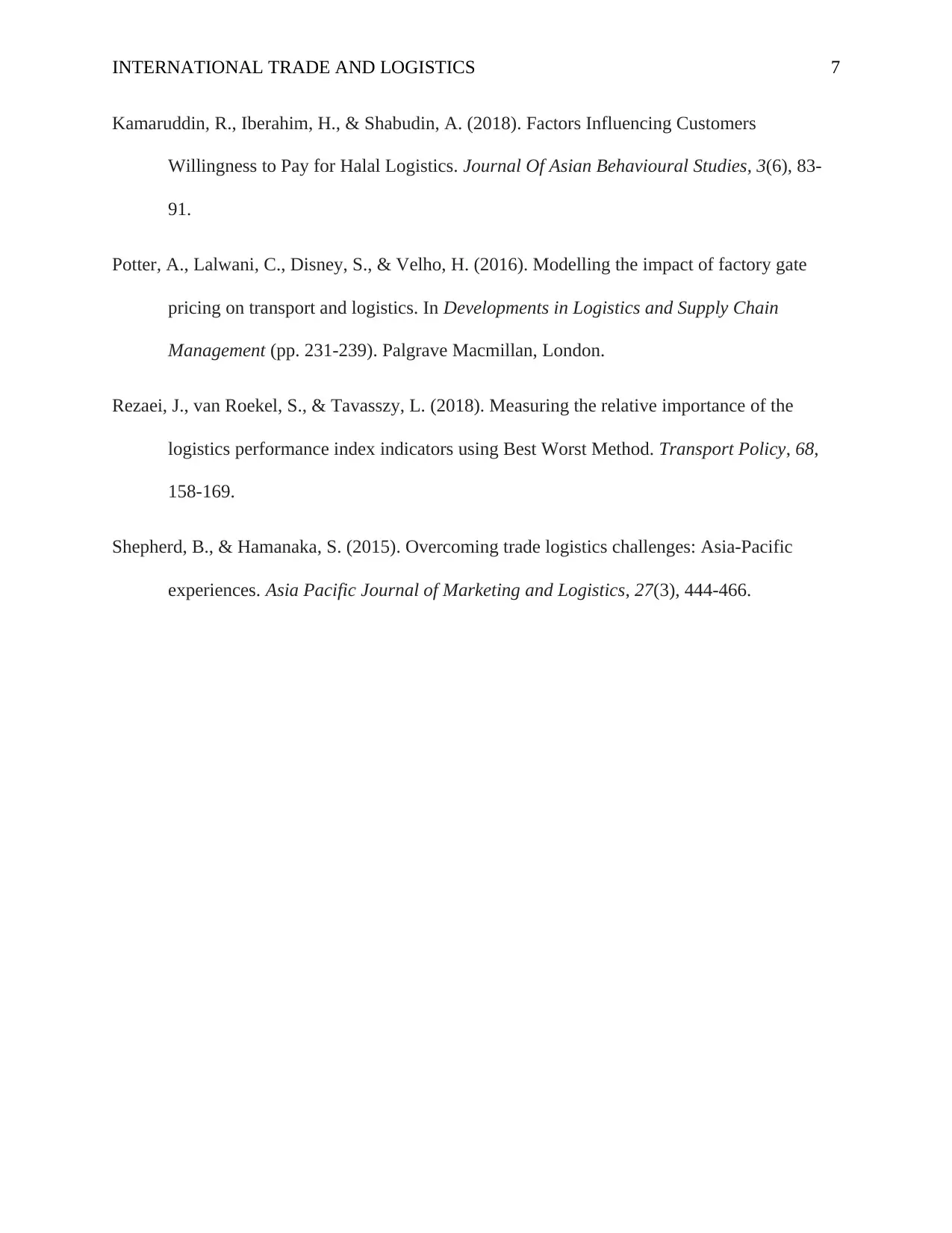
INTERNATIONAL TRADE AND LOGISTICS 7
Kamaruddin, R., Iberahim, H., & Shabudin, A. (2018). Factors Influencing Customers
Willingness to Pay for Halal Logistics. Journal Of Asian Behavioural Studies, 3(6), 83-
91.
Potter, A., Lalwani, C., Disney, S., & Velho, H. (2016). Modelling the impact of factory gate
pricing on transport and logistics. In Developments in Logistics and Supply Chain
Management (pp. 231-239). Palgrave Macmillan, London.
Rezaei, J., van Roekel, S., & Tavasszy, L. (2018). Measuring the relative importance of the
logistics performance index indicators using Best Worst Method. Transport Policy, 68,
158-169.
Shepherd, B., & Hamanaka, S. (2015). Overcoming trade logistics challenges: Asia-Pacific
experiences. Asia Pacific Journal of Marketing and Logistics, 27(3), 444-466.
Kamaruddin, R., Iberahim, H., & Shabudin, A. (2018). Factors Influencing Customers
Willingness to Pay for Halal Logistics. Journal Of Asian Behavioural Studies, 3(6), 83-
91.
Potter, A., Lalwani, C., Disney, S., & Velho, H. (2016). Modelling the impact of factory gate
pricing on transport and logistics. In Developments in Logistics and Supply Chain
Management (pp. 231-239). Palgrave Macmillan, London.
Rezaei, J., van Roekel, S., & Tavasszy, L. (2018). Measuring the relative importance of the
logistics performance index indicators using Best Worst Method. Transport Policy, 68,
158-169.
Shepherd, B., & Hamanaka, S. (2015). Overcoming trade logistics challenges: Asia-Pacific
experiences. Asia Pacific Journal of Marketing and Logistics, 27(3), 444-466.
Secure Best Marks with AI Grader
Need help grading? Try our AI Grader for instant feedback on your assignments.
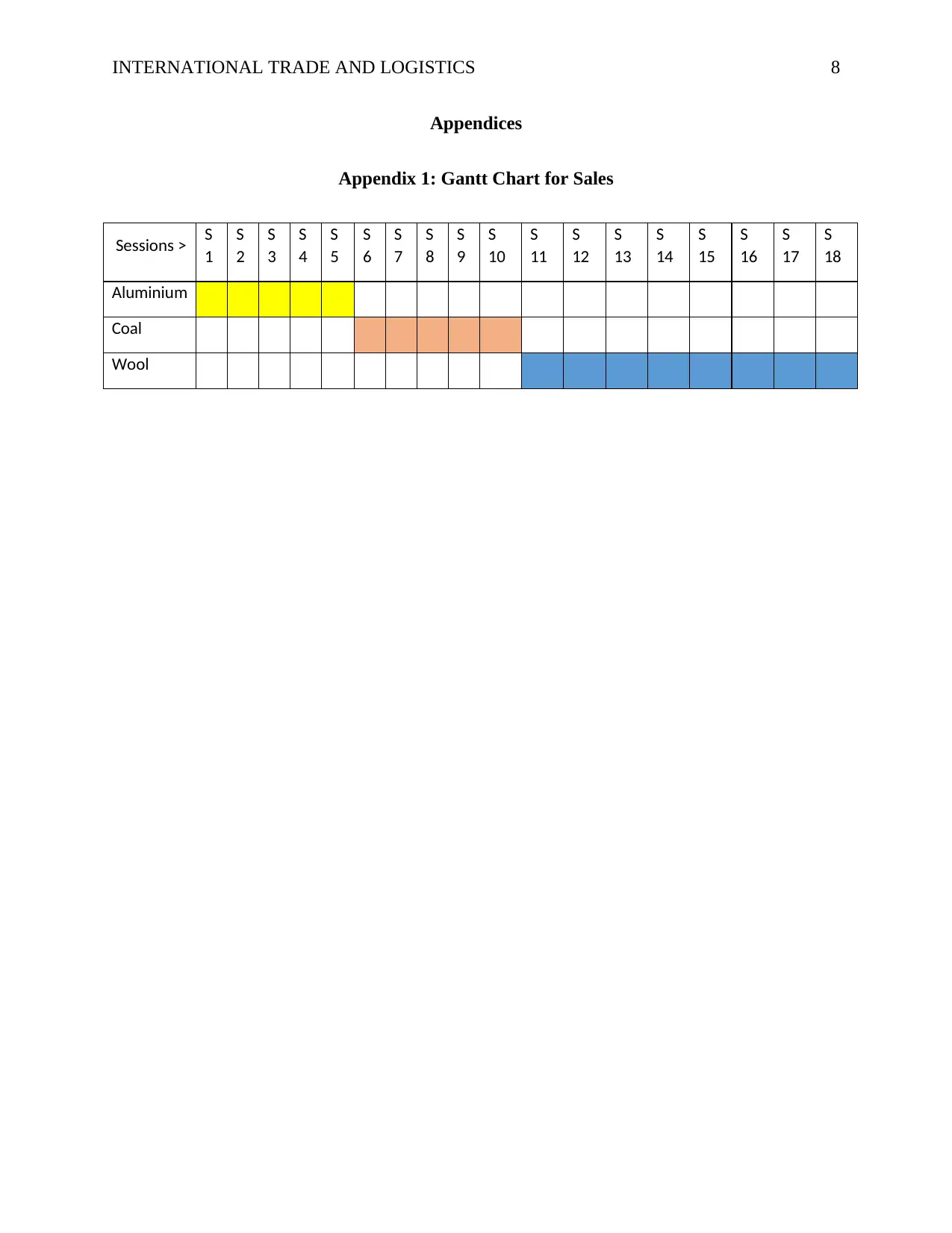
INTERNATIONAL TRADE AND LOGISTICS 8
Appendices
Appendix 1: Gantt Chart for Sales
Sessions > S
1
S
2
S
3
S
4
S
5
S
6
S
7
S
8
S
9
S
10
S
11
S
12
S
13
S
14
S
15
S
16
S
17
S
18
Aluminium
Coal
Wool
Appendices
Appendix 1: Gantt Chart for Sales
Sessions > S
1
S
2
S
3
S
4
S
5
S
6
S
7
S
8
S
9
S
10
S
11
S
12
S
13
S
14
S
15
S
16
S
17
S
18
Aluminium
Coal
Wool
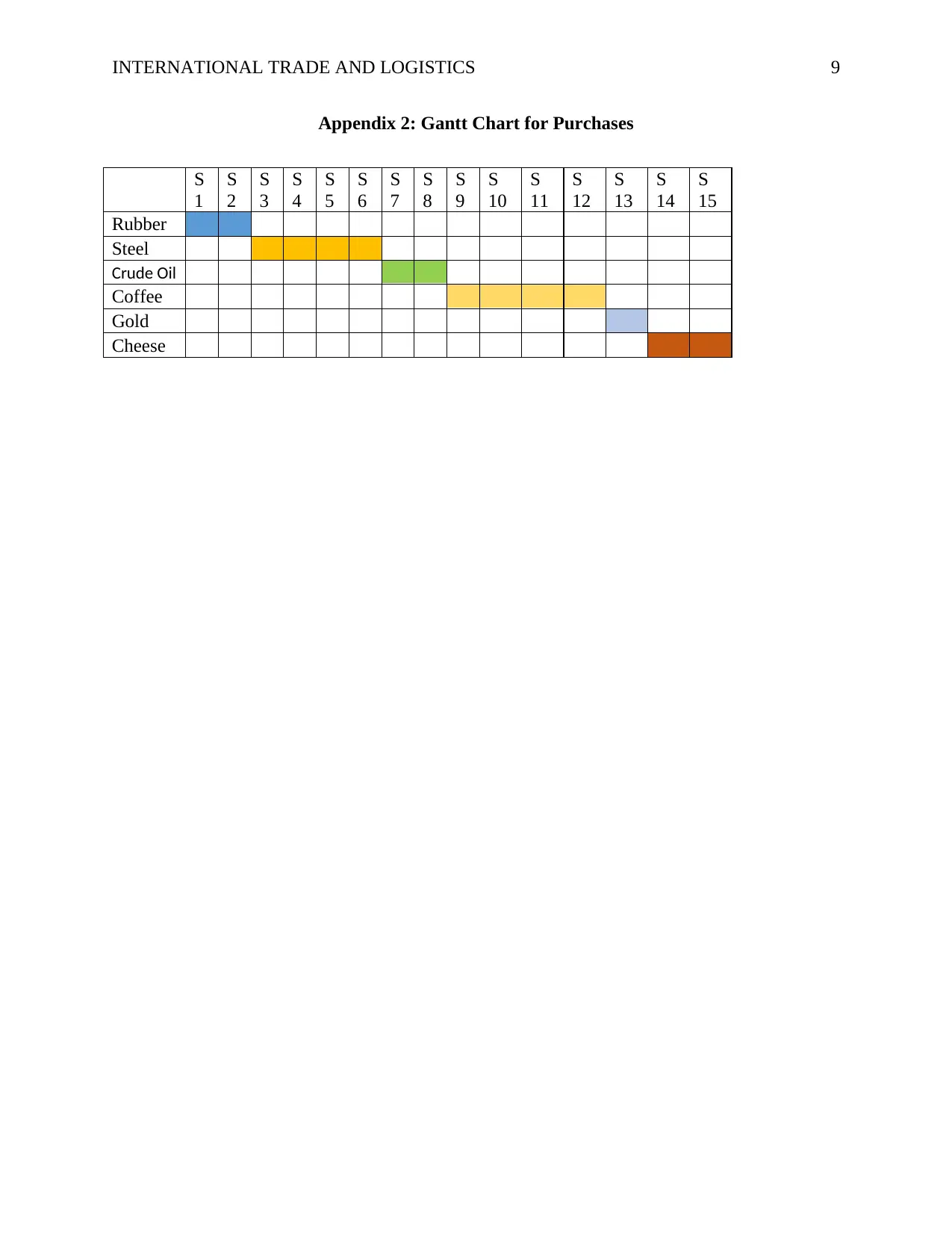
INTERNATIONAL TRADE AND LOGISTICS 9
Appendix 2: Gantt Chart for Purchases
S
1
S
2
S
3
S
4
S
5
S
6
S
7
S
8
S
9
S
10
S
11
S
12
S
13
S
14
S
15
Rubber
Steel
Crude Oil
Coffee
Gold
Cheese
Appendix 2: Gantt Chart for Purchases
S
1
S
2
S
3
S
4
S
5
S
6
S
7
S
8
S
9
S
10
S
11
S
12
S
13
S
14
S
15
Rubber
Steel
Crude Oil
Coffee
Gold
Cheese
1 out of 12
Related Documents
Your All-in-One AI-Powered Toolkit for Academic Success.
+13062052269
info@desklib.com
Available 24*7 on WhatsApp / Email
![[object Object]](/_next/static/media/star-bottom.7253800d.svg)
Unlock your academic potential
© 2024 | Zucol Services PVT LTD | All rights reserved.





